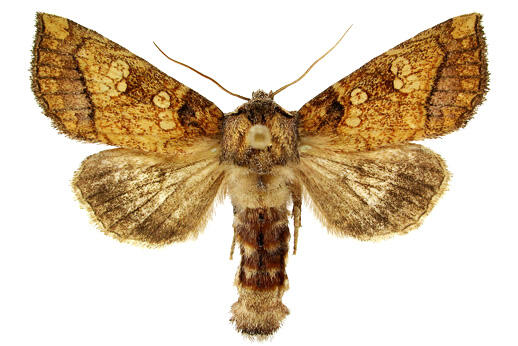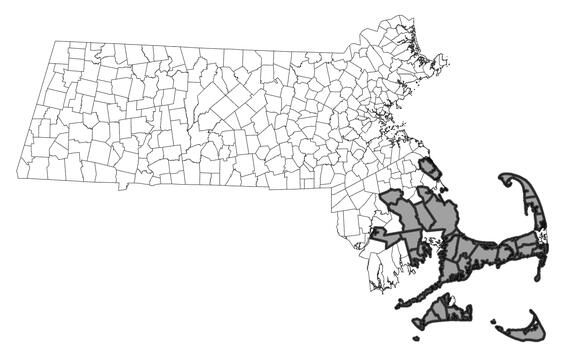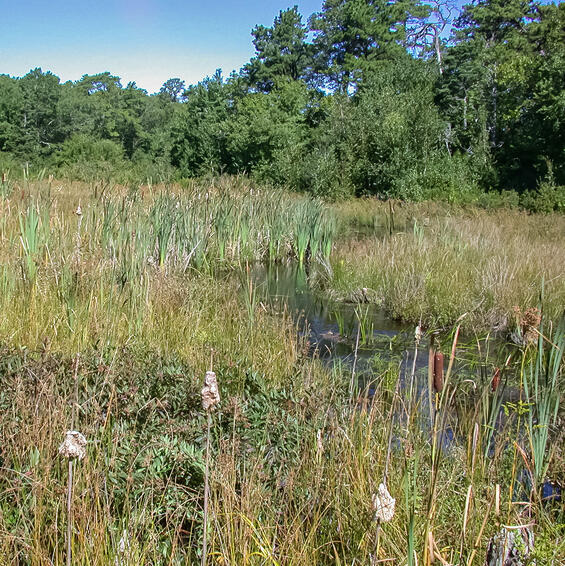- Scientific name: Papaipema sulphurata
- Species of Greatest Conservation Need (MA State Wildlife Action Plan)
- Threatened (MA Endangered Species Act)
Description

Water-willow stem borer, Papaipema sulphurata
The water-willow stem borer (Papaipema sulphurata) is a noctuid moth with a wingspan of 32-38 mm (1.3-1.5 in). The forewing is yellow, overlaid with darker, orangish-brown, with purplish-brown shading in the basal and terminal areas. The postmedial line is double (the distal line dark, purplish-brown, thicker than the orangish-brown proximal line), largely straight but curving in toward the costa distal to the reniform spot. An orangish-brown, diffuse and faint median line may be present. The antemedial line is orangish-brown in color and double, with the proximal line often obscured by the basal shading. The reniform spot is a large ring, outlined in orangish-brown and filled with yellow matching the ground color of the forewing. The orbicular and claviform spots are relatively large, the orbicular relatively round and the claviform elongate; like the reniform, both are outlined in orangish-brown and filled with yellow. The hind wing is tan, slightly tinged with orange; a faint discal spot may be present. The elongate scales of the head and thorax are a variable mixture of yellow, orangish-brown, and purplish-brown, matching the overall coloration of the forewing. The abdomen is tan, slightly tinged with orange, matching the color to the hind wing. The burdock borer (Papaipema cataphracta) is very similar, but the forewing is less saturated with the warm, orange tint of the water-willow borer (Forbes 1954).
Life cycle and behavior

In Massachusetts, water-willow stem borer moths fly from mid-September to mid-October. Eggs overwinter, hatching in early summer. The larvae bore into and feed internally on the stems of water-willow (Decodon verticillatus), becoming fully grown and pupating in late August or early September.
Distribution and abundance
The water-willow stem borer is endemic to southeastern Massachusetts, occurring in eastern Bristol and Plymouth Counties and on Cape Cod and the offshore islands.

Distribution in Massachusetts.
1999-2024
Based on records in the Natural Heritage Database.
Habitat
The water-willow stem borer inhabits shallow portions of coastal plain wetlands (freshwater marshes, swamps, edges of lakes and ponds, riparian areas, abandoned cranberry bogs, vernal pools, etc.) where water-willow (Decodon verticillatus) grows.
Healthy habitats are vital for supporting native wildlife and plants. Explore habitats and learn about conservation and restoration in Massachusetts.

Freshwater marsh with water-willow (Decodon verticillatus), habitat for the water-willow stem borer. Habitat managed by Mass Audubon at Skunknett River Wildlife Sanctuary.
Threats
The water-willow stem borer is threatened by habitat loss and disruption of the natural hydrology of its habitat. Other potential threats include invasion by exotic plants, eutrophication or other water pollution, riverbank stabilization, aerial insecticide spraying, non-target herbicide application, and off-road vehicles. This species has an unusually small geographic range, which may make it especially vulnerable to climate change. Its ability to shift or expand its range in response to climate change, or to adapt within its current range, is not known.
Conservation
Land protection and habitat management are the primary conservation needs of the water-willow stem borer in Massachusetts. In particular, coastal plain wetlands (freshwater marshes, swamps, edges of lakes and ponds, riparian areas, abandoned cranberry bogs, vernal pools, etc.) where water-willow (Decodon verticillatus) grows should be conserved, restored, and managed to maintain habitat for this species and other species dependent on such habitat.
Survey and monitoring
The distribution of the water-willow stem borer in Massachusetts is well documented. Known populations of this species should be surveyed to document persistence at least once every 25 years; every 10 years is more desirable when practicable.
Management
Management of coastal plain wetlands (freshwater marshes, swamps, edges of lakes and ponds, riparian areas, abandoned cranberry bogs, vernal pools, etc.) where water-willow grows should include restoring and/or maintaining natural hydrology and control of invasive exotic plants. Habitat condition should be monitored and management adapted as needed.
Research needs
The natural history and conservation needs of the water-willow stem borer are well understood. However, this species may be especially vulnerable to climate change; the future effects of a warming climate on this species are unpredictable and should be studied.
References
Forbes, W.T.M. 1954. Lepidoptera of New York and Neighboring States. Part III. Memoir 329, Cornell University Agricultural Experiment Station, Ithaca, New York. 433 pp.
Contact
| Date published: | March 24, 2025 |
|---|